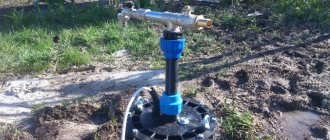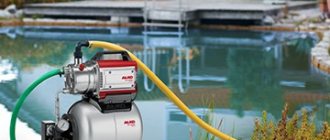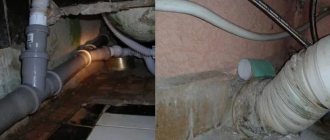How to clean a well from silt and sand with your own hands
Well cleaning methods include various methods using labor-intensive manual technologies or using submersible electric pumps. The cleaning problem is complicated by the fact that drainage electric pumps specially designed for working with dirty liquids, due to their overall dimensions, cannot be used in deep wells. With their help, you can pump out contaminated water from an artesian well or a source with a very large diameter casing pipe, which no one installs.
Bailer
A bailer is a mechanical device for cleaning wells from contaminants. Structurally, it is made in the form of a piece of steel pipe with a locking device at the end, which can be made in the form of a valve or a ball. During operation, the pipe, suspended by a cable, smoothly lowers to the bottom, then rises to a distance of about 50 cm and is released.
When it falls, the ball or valve that locks at the bottom of the pipe rises, and contaminated liquid containing clay and sand enters the bailer.
Figure 6. Lifting clay rock and sand particles with a bailer
When the steel pipe begins to be raised again, the ball or valve closes the lower hole, preventing the collected dirt from flowing back into the well.
During operation, the pipe is thrown to the bottom several times, the bailer is then removed to the surface, the procedure is repeated until the silt deposits are completely removed from the bottom of the source.
Well cleaning with a vibration pump
Cleaning a well with a vibration pump is the most effective method if the well produces water containing clay and sand. This is due to the operating principle of vibrating devices, in which water is drawn in using suction by a rubber valve that performs reciprocating movements.
Rice. 7 Vibration-type electric pump for cleaning wells and wells
This allows the vibration pump, unlike centrifugal types of submersible electric pumps, to operate in an environment with a high content of sand and clay impurities.
During operation, the vibration pump drops to the bottom, then rises 20 cm and turns on. To simplify the work, you can make an addition by tying a steel rod to the body, which during operation will rest against the bottom, preventing the pump from falling below a given level.
If there is a second electric pump (for example, one that was removed from the source), you can connect it to work, supplying the liquid raised to the surface after settling in a large container through a hose back into the well hole. The water going to the bottom from the surface will effectively lift particles of clay and sand, after which the vibration pump will push the dirt to the surface.
Fig.8 Method of source cleaning using a vibration electric pump
Cleaning a well with a deep electric pump
Centrifugal electric pumps used for water intake are not designed to work with dirty, cloudy liquids - using them for these purposes can lead to failure of the pumping equipment. A pump that is more suitable for working with sand and clay rock is a screw (screw) pump, which can be used to pump out dirty liquid without harmful consequences.
The problem is solved by using an additional electric pump, as in the example above, or using a special mechanical ripper, which is suspended by a nylon cord and immersed in the well bottom, loosening bottom sediments.
Rice. 9 Deep pump for pumping out fine impurities
There are many reasons why muddy water comes out of a well; sometimes the problem cannot be solved (industrial enterprises, expiration of its service life) and the well has to be closed and a new one installed in another location; in other situations, you can cope with the problem yourself. The main cause of pollution is siltation - the problem can be effectively solved with your own hands using mechanical methods or electric pumping devices to lift and pump out dirt from the bottom of the source.
Precautions during well cleaning
In order to prevent damage to the system during cleaning, you must follow basic rules:
- Do not use equipment for cleaning that is not designed for this work.
- During the cleaning process, you need to constantly monitor it and not leave the well and equipment unattended.
- Stop pumping immediately if large particles of metal or plastic appear.
The video will tell you what other cleaning methods exist. This article gives only some recommendations for cleaning from silt and sand. Periodic cleaning will increase the life of the pumping equipment and keep the system clean and tidy.
Why does water from a well, even an artesian one, smell?
Since childhood, we have heard about tasty and clean cold water from a spring or well, restoring strength to heroes. Therefore, we expect that in real life, groundwater will be just as refreshing and almost sterile. But a thick layer of earth over water is not a sealant. And through it, all kinds of impurities slowly penetrate into the water from above: metals, gases, microorganisms, nitrates and everything else. Iron and other metals oxidize, organic matter, for example, the remains of algae, rots, and everyone knows what it smells like, for example, ammonia.
If the water begins to smell unpleasant, you should first find out the reason. In the case of artificial origin, the issue is resolved by contacting the appropriate services. If the cause is natural, you need to select an accompanying cleaning method.
What to do on your own?
find out exactly why sand is coming out of a well , but you can try to solve the problem yourself:
- pump water to the very bottom using a vibration pump;
- raise the pump 15-30 cm so that it is above the sand level.
If these basic measures do not help, do not hesitate and call specialists.
You can leave a request on the company’s website or by calling 930-317 in Tyumen, and our specialist will contact you shortly.
Sand is pulled through a layer of gravel backfill
The most common cause of sand build-up is a faulty filter.
If the well is made according to all the rules, then its bottom is a tightly welded end. Old regulations stated that the weld end could be replaced with a conical point oak chop. However, at present, in the vast majority of cases, instead of welding, crushed stone is simply poured into the pipe, similar to how this is done when constructing wells. However, the problem is that water flows into the well and the well at completely different speeds.
The grid of any well becomes clogged after some time. Its resistance begins to exceed the resistance provided by the gravel backfill. Water arrives through the backfill and carries sand into the well. Grains of sand can have completely different sizes - from the smallest to the very large.
In addition, if such a well is equipped with a high-power pump, during its operation the gravel plug may have less resistance than even a clean filtration mesh. Under such circumstances, sand begins to flow very quickly into the well through the gravel fill. And it can be pulled to the level of the pump, i.e. quite high.
Quite often, this phenomenon is accompanied by the fact that the clay, liquefied under the constant influence of a water flow, will no longer hold the gravel backfill. And because of this, muddy water with clay admixture will flow.
Sand can pass through a hole in the casing
Proper connection of casing pipes is very important to protect the borehole from debris and impurities.
In this case, we mean a fistula in the wall of the product. The hole may rot after some time of operation of the pipe, or it may appear in the place of a broken or poorly welded pipe joint. This option is the most common. Moreover, it has many different manifestations. Determining the presence of a fistula is quite simple. If the water contains impurities of sand grains of different sizes, then a fistula occurs.
Screwed casing pipes last an average of 50 years. The service life of welded pipes rarely exceeds 20 years. During this period, the wall may rot and a fistula will appear in it. If welding is used, sometimes inattentive or unscrupulous drillers do not weld the joints completely or incorrectly. In such situations, the water becomes contaminated with sand through a flat, wide fistula.
It also happens that workers do not completely tighten the threads at the joints. After some time, the rather thin metal in such areas completely rots. Because of this, the lower part of the pipe may also come off completely. Such situations greatly surprise well owners. Not only does the bottom of the casing disappear, but the flow rate also decreases.
Well cleaning scheme using pumps.
Budget vibration pumps eventually start to not work as they should. For example, the turns of wire that are needed to press the mesh to the casing may become loose. As a result, a gap will appear between the casing pipe and the filtration mesh. Sand will begin to flow through this gap. Sand grains usually have different sizes, but coarse grains, as a rule, are not found.
In the process of using wells “on limestone,” cracks quite often appear at the junction of the limestone slab and the casing pipe. This happens for several reasons. Firstly, due to the negligence of the craftsmen when making this joint. Secondly, due to the displacement of the casing pipe or even the entire shallow caisson under the influence of swollen, frozen soil. It is quite simple to establish that the sand went into the water precisely because of this. In such a situation, the bottom of the well will rise to the bottom edge of the casing. Sand grains can vary in size - from small impurities to huge pieces of limestone.
By the way, raising the bottom of the well to the height of the fistula is a common symptom for all cases discussed in this section. There are exceptions, of course, but they are extremely rare.
Incorrectly selected or installed grid
If the water comes with sand, then first of all you need to check the mesh. If it is initially selected incorrectly, then clogging of the well will occur quite slowly. It will take at least 3-4 years for the mesh to become completely clogged.
Sanding will occur at a much faster rate if the selected grid cells are larger than the sand grains of the aquifer in your region. In addition, the following may lead to this situation:
- Damage to the mesh during installation.
- Damage to the casing pipe over time.
- Lack of protection of the source mouth from floods, etc.
Diagram of a well with a filter.
Heavy sand particles settle to the bottom of the well. Over time, they will fill the sump, rising into the filter area and completely filling it. Because of this, access to the source of water will be difficult. If the horizon is not very water-bearing, the productivity of the well will become less than the productivity of the pump with which it is equipped, and the water will run out. If there is quite a lot of water, the sand will rise along with the water and get caught by the pump. Users will receive sand-contaminated water.
Under the influence of sand, impellers begin to deteriorate, filters and pipelines become clogged, automation, expansion tanks and household plumbing fixtures suffer. And constant pumping of sand significantly reduces the service life of the well itself.
Also, the reason that water comes with sand may be a torn mesh. This happens quite often: if no more than 3-4 years have passed from the day the well was created until sand appears in the water, and the sand does not “run out”, and the impurities have different sizes - from the smallest grains of sand to almost pebbles, then almost 100% It's a torn mesh.
Preventive measures
To prevent the well from producing sand over time and causing trouble to its owner, it is important to take a number of preventive measures.
- Completely pump (flush) the source after drilling it. It is important to do this until the water comes out completely clean.
- Correctly calculate the fraction of filter mesh cells based on the size of sand grains. This can be done by experienced professionals.
- Monitor the strength and reliability of all connections of the casing pipe during its installation.
- Use a pump whose technical characteristics correspond to the performance of the source. A unit that is too powerful will either deplete the well or drive sand.
- Operate the hydraulic structure regularly (even in winter). Seasonal downtime leads to silting of the filter. If it is impossible to avoid seasonal operation of the well, it is advisable to come to the site once a month and pump out at least 100-150 liters of water.
It is always easier to prevent a problem than to solve it later.
How to get rid of the smell of well water
Organic smell. First of all, it is necessary to flush the well, since, most likely, organic compounds are retained in it and then rot, “aromatizing” the water. In addition, you will have to spend money on appropriate filters to remove the smell.
Hydrogen sulfide is removed using different methods. The most common is the installation of an aeration column. The method is good because there are no reagents. The disadvantages include the need to allocate free space and, most often, serious installation and maintenance costs.
Iron. Despite the fact that the smell itself quickly disappears, it usually does not exist alone. Along with it there is a corresponding taste of water, color, turbidity, rusty sediment on heating devices and many other surfaces in contact with ferrous water.
Petroleum products and ammonia are removed by various filters, from carbon to titanium. The first step is also often to flush the well.
What kind of iron is there in water?
Iron-laden water is a common problem with bore or well water. However, it also does not bypass city residents. In wells, oxidized iron often predominates, which can be immediately determined by rusty water. In constant contact with oxygen, iron easily oxidizes and is quite simple to clean.
With dissolved iron it is somewhat more complicated. It is in the well that it occurs most often and at first is almost imperceptible. Clear-looking water with dissolved iron does not always have an unpleasant odor. Often the metal is detected after water has been allowed to sit in air. When heated, iron also quickly oxidizes and leaves a rusty coating on expensive equipment. And if changing a kettle is not particularly difficult, then repairing or buying a new boiler or boiler is not the cheapest thing.
Despite the fact that the smell of iron for the most part disappears quickly, it is also unpleasant. To eliminate the odor of well water caused by iron, a suitable filter is installed.
There are different options, from reverse osmosis and aeration units to reagent filters and ion exchange. A combination of cleaning efficiency, compactness and cost-effectiveness will be a reagent-free filter made of 100% titanium. When ground into powder, titanium is sintered into a tube with a porous structure.
All fine impurities (from 0.8 microns) are retained by the pores of the filter. Dissolved iron also cannot pass the titanium barrier, since the particles oxidize upon contact with titanium dioxide. After which the oxides also remain outside the cartridge.
In addition to iron and the accompanying odor, titanium filters also remove the following impurities:
- ammonia
- manganese
- free chlorine (7 times reduction)
- petroleum products
- nitrates
- radon.
Purifying water from unpleasant odors is not just about increasing the level of comfort. Excessive levels of impurities causing these odors are harmful to health upon contact with such water.
Harm to health - impurities in well water
Hydrogen sulfide causes poisoning when inhaled: dizziness, lethargy, and decreased overall tone are observed. Particularly high concentrations can be lethal. The matter is not limited to health risks - plumbing fixtures easily fail with frequent and prolonged contact with hydrogen sulfide.
An excess of iron can cause various ailments with regular ingestion of such water. We get the iron we “need” from food, but the excess that comes with water cannot be eliminated completely naturally. As a result, organs begin to accumulate it. Symptoms of iron poisoning:
- lethargy
- fatigue
- decreased immunity
- dysfunction of the kidneys, liver, and other internal organs
- joint problems
- skin rashes, allergic reactions, itching.
Where does sand come from in a well?
For many, water contamination comes as an unpleasant surprise, and they ask the understandable question of why it happened that when drilling at great depths, where artesian layers lie, sand and water flow.
It is important to note that a small amount of it is allowed by sanitary standards and is not considered a tragedy. If it does not exceed 0.1 -1 g/l, such water is suitable for use and will not cause harm to health.
The presence of fractions of foreign solid particles in the water mass supplied by the pump may explain why sand and water come from a new well. It must be taken into account that the horizons of the formations are located directly next to the sandy horizons. Passing through them, masses of water capture a small amount of sand, and the pump delivers it upward.
REASONS FOR REDUCED WELL PRODUCTIVITY
No matter how carefully and carefully the owner of an autonomous system treats his hydraulic installation, from time to time it still gets dirty and needs to be cleaned. The reasons for silting of water wells can be different, ranging from the geological features of the area and ending with the intensity of operation. Regardless of what caused the well contamination, the consequences are always identical. First of all, the productivity of an autonomous hydraulic installation is initially reduced. If nothing is done promptly, not only expensive well equipment may fail in the future, but the well itself may become unusable.
The most common reason for a sharp decrease in well production is colmatage of filters and the filter zone, caused by the following factors:
- Blockage of filter holes by rock particles of various sizes present in the aquifer. It is called mechanical colmatage.
- The appearance of deposits on structural elements of filters and in the near-filter zone. It is called physicochemical colmatage, which is based on natural secretions of groundwater, preferably an iron or silicate compound, converted into insoluble rocks.
- Clogging of well elements by insoluble compounds from organics and inorganics. It is called biochemical colmatage.
Most often, well colmatage occurs under the influence of the turbulent regime inside the bottomhole zone, justified by the high rate of formation water inflow. Due to high turbulence, downhole equipment is very quickly subject to oxidation and corrosion processes.
When you are faced with the question of what to do if a well is clogged, how to clean it correctly and effectively, we recommend that you contact specialists who have sufficient experience in performing this type of work. Highly qualified employees are always ready to help and promptly eliminate contamination of wells of any complexity.
Contact us! Our company specializes in servicing any autonomous water supply systems, so it can easily restore the flow rate of water wells in the Moscow region and in all areas of Moscow. Our prices for well cleaning in the Moscow region are the lowest in the region, so by cooperating with us, you can save a lot.
Well cleaning
Cleaning a well from sand particles is carried out using:
Pumping is carried out with a special pump, which can lift large fractions of sand to the top. If such equipment is not available, then a submersible device that does not require large financial costs is suitable.
Cleaning a well with sand.
Pump cleaning
Before starting work, prepare a container where the water will be drained. The site must be located far from the source, otherwise liquid will be absorbed through the soil. The procedure is carried out in stages:
- lower the pump into the well, putting a 15 cm long tube on the suction site;
- turn on the device and set the height at which it will be located;
- lower the device gradually, based on the volume of pumped out liquid.
If professional equipment is used, then preference is given to:
- a screw pump, the permissible supply of sand in which is 2 kg/m³;
- a centrifugal apparatus characterized by the content of sand particles in water up to 1.5 kg/m³.
Pressurized water supply
This technique is suitable if there are dense deposits at the bottom of the well. To carry it out you will need:
- install the pipe in the casing so that the bottom of the well is close;
- connect it to a high-power compressor if air is supplied to the bottom;
- attach a volumetric tank if water goes to the bottom;
- turn on the device when the system is ready and clean the well.
When choosing this method, water rises under high pressure and sprays out. For this reason, electrical equipment is covered with film and located further from the source.
Source of the article: https://scvazina.ru/iz-skvazhiny-idet-voda-s-peskom-chto-delat











